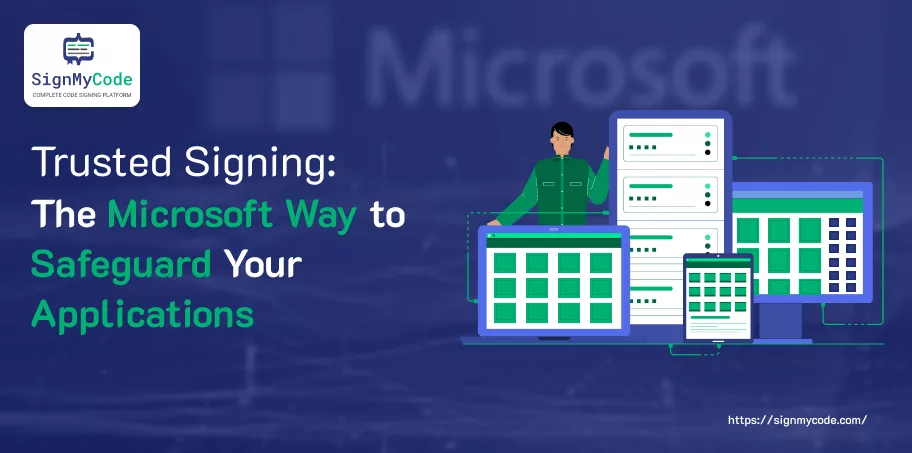Trusted Signing: The Microsoft Way to Safeguard Your Applications

Introduction
With the advent of digital technology that makes its way into every sphere of our lives, software’s reliability and integrity are particularly important. Hackers never stop trying to gain unauthorized access and exploit application weaknesses to achieve their goals and gain from outact.
This can mean peril respectively for individuals and organizations. One of the tech industry’s crème de la crèmes – Microsoft, well known for its innovations and security- has formulated a way to deal with the challenge and released ‘Trusted Signing’.
This highly secure code signing service is only available in public preview. This revolutionary solution is meant for convenience and no added costs. It provides more security and more confidence for the developers and users.
What is Microsoft Trusted Signing?
The cloud-based micro-tuned service of Microsoft Trusted Signing is a solution that makes code signing for applications, drivers, and firmware more accessible.
It uses Azure secure data centers to develop a dependable, centralized, and trusted environment for code signing management.
As opposed to the complex setup of on-premises infrastructure, Trusted Signing provides light solutions that are scalable enough to be applied by companies of all sizes, small ones and even large enterprises.
Key Features of Trusted Signing:
Secure and Trusted:
Trusted Signing implements the ISO industry-standard cryptographic algorithms and HSMS to deliver the maximum level of security and integrity for your code signing workflow. This security’s robustness makes it challenging to modify code, have it stolen, or engage in other malicious behaviors.
Centralized Management:
The main advantage is that you need only one management console to manage all diplomats’ activities on coding, signing, certificates, and policy, which is in one view. It brings the management procedure that cuts the complicated process and puts it in a position of control.
Scalability and Flexibility:
Being an on-the-cloud service, Trusted Signing can compress itself to meet your organization’s growing needs by signing code at a reasonable cost and with efficiency. While small, as a part of the winning team, we know how to ensure that your security and requirements are perfectly balanced every step of the way.
Integration with Azure Services:
Azure service integration, a unique feature of Trusted Signing, allows you to use it with other services for seamless operations, thus improving your security posture and perfecting the development workflow. With the extensive range of services onboard, Azure allows us to create a robust and secure application development platform.
Recommended: Unleash Your Startup’s Potential with Microsoft Azure Cloud Computing
Benefits of Microsoft Trusted Signing
Simplified Code Signing Process:
Clouds out the care of code verification to Microsoft’s secure cloud, enabling developers to focus on their principal activities rather than neglect their critical activities. It saves developers time and resources.
It relates to the pruning of the clutter, such as administration and maintenance of code signing solutions that are on-premises, thus giving the team a lot of time to fully concentrate on the software delivery.
Improved Security Posture:
Trusted Signing enables you to safeguard your code’s integrity and authenticity from the possibility of modification by unlawful and unauthorized intruders.
Through the implementation of Microsoft HSMs with cryptographic algorithms, you can ensure the security of your application devices from malign actors, and users will always be in a position of trust.
Recommended: Comprehensive Guide on Azure Key Vault: Key Management and Difference
Centralized Management and Visibility:
Overseeing the centralized management console allows you to have all current code signing activities within it, allowing you better control, auditing, and compliance. Such transparency enables organizations to track and review their signed software items’ operations to conform to internal policies, laws, and regulations.
Scalability and Cost-Effectiveness:
Through the cloud interface, Trusted Signing can help you when you need more server space and choose better if you don’t need much. But the cost of this service will always come first.
At the same time, you can do it without costly on-premises infrastructure. Instead, you can use the scalability of the cloud so that you can pay for the resources you demand at any time.
Integration with DevOps Pipelines:
Using seamless integration, you can incorporate Trusted Signing into your existing DevOps framework without changing the software delivery process, resulting in safe software deployment. This automatization helps sign code without effort, reducing human errors and ultimately speeding up your software delivery pipeline.
Recommended: Code Signing for Secure DevOps and DevSecOps: Centralized Management and Automation
Compliance and Trust:
Not only single-handedly but Trusted Singing can act as a tool for organizations to inspire their customers and partners and thus compliance over security and trust.
With well-structured security components and auditing functions provided by Trusted Signing, organizations can conform to professional standards and regulatory requirements and preserve their good name and credibility.
Take advantage of this opportunity to elevate your code-signing practices. Sign up for the public preview of Microsoft Trusted Signing today, experience the future of secure code signing, and take your software security to the next level. Embrace the power of Trusted Signing and unlock a world of seamless, safe, and compliant code signing experiences.
Conclusion
Microsoft Trusted Signing is a game-changer in code signing, offering a secure, scalable, and cost-effective solution for organizations of all sizes.
By leveraging the power of Azure’s secure infrastructure, Trusted Signing simplifies the code signing process while enhancing trust and integrity for your applications, drivers, and firmware.
As the service continues to evolve, it is poised to become an essential component of modern software development practices, ensuring a secure and trusted digital ecosystem.
Frequently Asked Questions
Is Microsoft Trusted Signing compatible with On-Premises Code Signing Solutions?
Trusted Signing technology is built to integrate easily into on-premises code signing infrastructure, enabling convenient cloud migration.
This blended approach allows enterprises to take advantage of Trusted Signing features while sustaining their existing investments easy to integrate into on-premises code signing infrastructure, thus enabling you to move to the cloud conveniently.
What Types of Code Can Be Signed with Trusted Signing?
The integrity of the code signed by Trusted Signing extends its functionality with code signing for a wide range of file types, such as executable files, drivers, firmware, etc. In all these areas that integrate desktop applications, mobile apps, or embedded systems, the signing procedure using Trusted Signing can suit your code signing needs.
How does Trusted Signing ensure the Security of my Code Signing Keys?
Azure’s HSMs Trusted Signing utilizes secure infrastructure coupled with hardware security modules to shield the signing keys for your apps.
HSMs can be considered tamper-proof hardware devices employed in protecting the cryptographic keys and the secure processing of some cryptographic operations to achieve the highest level of security for your code signing processes.
Can Trusted Signing be Integrated with my Existing Development Workflows?
Yes, Trusted Signing can be connected to all popular software development tools, and credit and personal debit card lenders only let you borrow according to your financial standing. It is integrated into your existing build processes and verifies the code authenticity, improving efficiency and decreasing workload.
How does Trusted Signing ensure Compliance with Industry Standards and Regulations?
Trusted Signing adheres to industry-standard security practices and protocols, ensuring compliance with various regulatory requirements.
Microsoft’s commitment to security and privacy helps organizations meet compliance obligations, such as those outlined in the General Data Protection Regulation (GDPR), the Health Insurance Portability and Accountability Act (HIPAA), and other industry-specific regulations.


